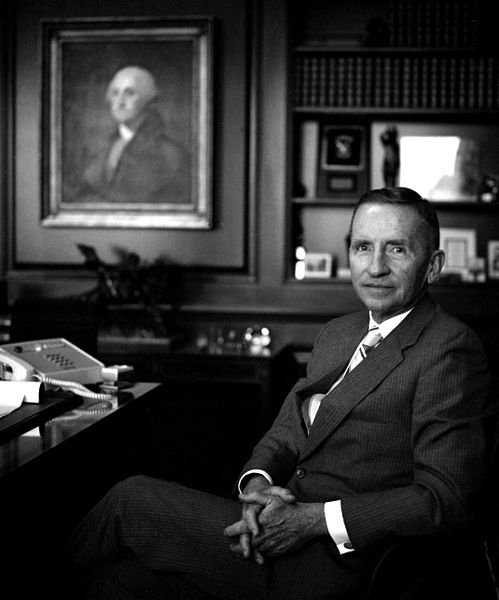When Smaller Was Better for the SBOE
Some lawmakers want to improve Texas’ State Board of Education by making it bigger. Thirty years ago, they tried to shrink their way to a better board.

 The Texas House Redistricting Committee spent Tuesday considering one of its interim charges: whether 15 seats are enough for the State Board of Education.
The Texas House Redistricting Committee spent Tuesday considering one of its interim charges: whether 15 seats are enough for the State Board of Education.
Committee chair Burt Solomons is concerned that such a small board makes for districts that are far too large. Today, each member represents about 1.7 million people in their decisions about curriculum and textbook standards.
“You need to do something so there’s a sense that you’re representing the people in your district and the children in the school districts and the parents of school children,” Solomons told the San Antonio Express-News’ Gary Scharrer.
Scharrer does a great job explaining the debate, and it’s one that’ll be with us for a while since the next round of redistricting isn’t till 2021. State Rep. Mike Villarreal tells the Express-News that the small, two-thirds white board doesn’t allow enough minority participation, while firebrand blogger Donna Garner says that the push to expand the board is really about trying to water down the power of its Real Conservative members.
Board members are split on the move, he writes, but outgoing member Terri Leo speaks for a majority of board members:
Terri Leo, R-Spring, is retiring after 10 years. She is against board expansion because, she fears, more members will make it harder to reach decisions on complicated issues with limited time and “too many chiefs at the table.”
“The Legislature has months to deliberate on an issue,” Leo said. “With plans to have the SBOE meeting only four times a year, for only two or three days — and one of those days reserved for public testimony — I don’t see how in the world we could reach a consensus on a multitude of issues in that short time frame with more members.”
The State Board of Education once had 27 seats “and failed for that very reason,” Leo said.
The decision to shrink the SBOE came in 1984, part of one of the most sweeping public education reforms in Texas history, led by a Select Committee on Public Education created by Democratic Gov. Mark White and led by Ross Perot. Shaking up the SBOE was just one of their recommendations, and far from the most controversial.
The committee’s recommendations—including a new state testing regime for grades three, six and 12, a 22-student cap for early elementary grades, and the “No Pass, No Play” policy for extracurriculars—ended up in a sprawling reform bill that year. Though the package also included a pay hike for teachers, it was a costly fight for Mark White, who was bumped out of office after just one term.
As Leo suggested, the SBOE was a mess in the early ‘80s.
An ungenerous New York Times editorial on the Perot commission suggested that “even Texans are beginning to wonder if an education centered on football and fundamentalist obscurantism is the best way to prepare their children for life in the 21st century.”
The Times pointed out the board’s zeal in shielding tender young eyes from anything remotely titillating. “It hasn’t approved a dictionary since 1969 because Merriam-Webster refused to purge its publications of words the board deemed offensive,” the Times wrote. The SBOE also didn’t require biology texts to mention Charles Darwin, but did insist they discuss “alternative theories of evolution.”
One of Perot’s most enduring zingers came at the SBOE’s expense: “Go to Austin and sit in on a meeting,” he said. “It costs you $5 to see a movie that funny. They got people on that board who think the earth is flat.”
How far we’ve come.
At Perot’s suggestion, the Legislature abolished the 27-member SBOE—which had been elected along Congressional district lines—and replaced it by a 15-member board, which for a short time was appointed by the governor.
“Some of the dynamics that we had during that time—they’re very similar to now, in that the board had fallen into kind of the hands of the religious far-right,” says Linda Bridges, president of the American Federation of Teachers’ Texas chapter, who watched the 1984 reforms unfold. “The appointed [board] was nothing more than an attempt to try to move away from elements that had taken over the elected body.”
Former U.S. Energy Secretary Charles Duncan, who sat on the Perot commission, was one of the appointees to the new board. Speaking from his Houston office Tuesday, Duncan said there was no science behind the new number of districts. “We thought 15 would be a good number,” he says. “We had a difficult time on some issues, even with 15.”
Four years later, Texas voters decided to do away with gubernatorial appointments for the SBOE and return to a directly elected board, but the 15 big districts remained.
“I’m not sure that the number was that big a deal—they didn’t want too many. Most of the debate was, you don’t want it too unwieldy,” Bridges says. “The restructuring that went on was really more about trying to negate the impact of the folks that had taken over the board—which is much like the debate today.”
Except that today, the Legislature’s looking at reforming the board by making it bigger.
“I think it’s not so much the size of the board, as it is how the board operates and who’s on the board, and what authority they have,” Bridges says. “The main power the board has today is about curriculum, and that becomes the battleground. We should be talking about, what are the rules they have to follow on input, instead of negating the experts” and making calls on curriculum based on ideology.
“To me,” Bridges says, “that’s probably more important than the number on the board.”
Portrait of Ross Perot by Allan Warren/Wikimedia Commons


